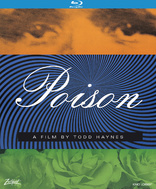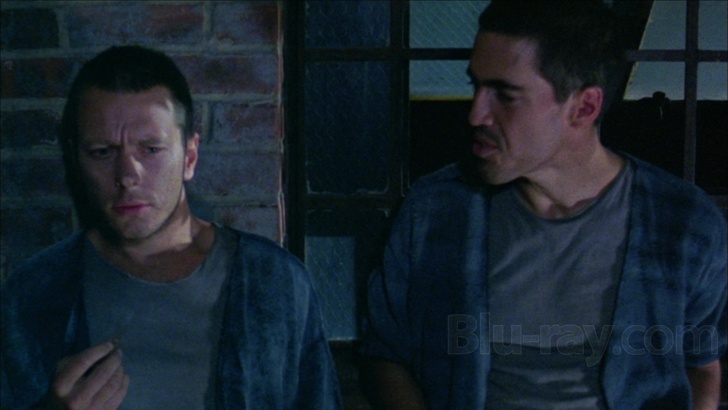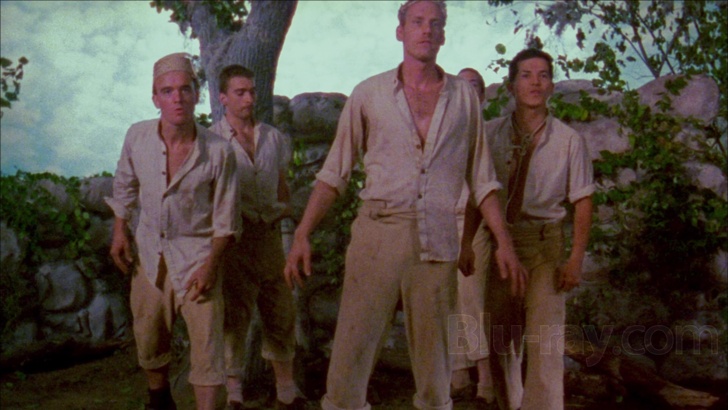Poison Blu-ray Movie
HomePoison Blu-ray Movie 
Kino Lorber | 1991 | 86 min | Not rated | Jun 29, 2021
Movie rating
6.5 | / 10 |
Blu-ray rating
| Users | 0.0 | |
| Reviewer | 3.5 | |
| Overall | 3.5 |
Overview
Poison (1991)
Three intercut stories about outsiders, sex and violence. In "Hero," Richie, at age 7, kills his father and flies away. After the event, a documentary in cheesy lurid colors asks what Richie was like and what led up to the shooting. In the black and white "Horror," a scientist isolates the elixir of human sexuality, drinks it, and becomes a festering, contagious murderer; a female colleague who loves him tries to help, to her peril. In "Homo," a prisoner in Fontenal prison is drawn to an inmate whom he knew some years before, at Baton juvenile institute, and whose humiliations he witnessed. This story is told in dim light, except for the bright flashbacks.
Starring: Edith Meeks, Millie White (I), Buck Smith, Anne Giotta, Lydia LafleurDirector: Todd Haynes
| Drama | 100% |
Specifications
Video
Video codec: MPEG-4 AVC
Video resolution: 1080p
Aspect ratio: 1.78:1
Original aspect ratio: 1.66:1
Audio
English: DTS-HD Master Audio 2.0 Mono (48kHz, 16-bit)
589 kbps
Subtitles
English SDH
Discs
Blu-ray Disc
Single disc (1 BD)
Playback
Region A (locked)
Review
Rating summary
| Movie | 4.0 | |
| Video | 4.0 | |
| Audio | 3.0 | |
| Extras | 3.0 | |
| Overall | 3.5 |
Poison Blu-ray Movie Review
Reviewed by Dr. Stephen Larson March 14, 2022Todd Haynes's feature debut Poison (1991) was as significant entry in what film critic B. Ruby Rich has called The New Queer Cinema. Also released that year which contributed substantially to that movement included Derek Jarman's Edward II, Gregg Araki's The Living End, and Gus Van Sant's My Own Private Idaho. I saw Haynes's experimental short, Superstar: The Karen Carpenter Story (1987) in a course titled Cinema and Ideology. Superstar told the Carpenters' meteoric rise in music and Karen's battle with anorexia nervosa using Ken and Barbie dolls as well as miniature sets. Poison is also experimental but in a radically different way. Haynes and his editor James Lyons intercut three storylines each beginning with an "H." “Hero” is the contemporary story made like a mocumentary using true crime and tabloid journalism techniques. Richie Beacon is a 7-year-old who fatally shoots his father with a revolver and flees from a bedroom window. Richie is missing and Haynes uses the hiatus during his disappearance to interview his mother, Felicia Beacon (Edith Meeks), neighbors of the Beacons, Richie's classmates, teachers, and one of his doctors. The “Horror” story is shot in black-and-white and hearkens to B-horror movies in the tradition of William Castle, Jack Arnold, and Ed Wood. Dr. Graves (Larry Maxwell) is unpopular around the hospital for a sex-drive elixir he's concocted in the lab. He drinks the serum, which causes him to develop lesions and sores on his skin. Dr. Nancy Olsen (Susan Gayle Norman) is one of his few advocates who's also romantically attracted to him. She sticks by him even when the tabloid media label him the "Sex Leper Killer." “Homo,” the third story, is set in two periods. The flashbacks take place at the Baton Boys’ Reformatory where Young John Broom (Tony Pemberton) and Young Jack Bolton (Andrew Harpending) first meet. Haynes cuts between that milieu with scenes in the Fontenal Prison where the two characters are now adults. John (Scott Renderer) has a sexual fetish for Jack (James Lyons). It's inspired by the writings of gay novelist Jean Genet (especially Miracle of the Rose) and Genet's short film, Un Chant D'Amour (1950).

Poison is filmed in a documentary style that has a very low-budget feel. Haynes and Lyons alternate between the three stories and leave the viewer hanging on what will happen next in each. The action proceeds as if one experiences a fever dream. I thought the "Hero" segment could have been more effective had it given the viewer more information about the Beacon case and a clear resolution to Richie's fate. It has the aura of one of those "unsolved mysteries." It's narrative style and "talking heads" delivery must have had an influence on Richard Linklater and his film Bernie (2011).
Poison Blu-ray Movie, Video Quality 

Zeitgeist Films has given Poison a thirtieth anniversary edition Blu-ray on this MPEG-4 AVC-encoded BD-50 (disc size: 35.51 GB). Zeitgeist's enclosed booklet doesn't contain much information about the film's restoration but Zeitgeist's DVD from a decade prior does. In the latter's 14-page booklet, Zeitgeist has a Criterion-like "About the Transfer": "Shot in 16mm, Poison was blown up to widescreen 35mm for its 1991 theatrical release presentation. This new high definition transfer was created on a Spirit Datacine from the original 35mm internegative, which is the best archival element available for the film. The MTI digital restoration system was also selectively used to remove scratches and stains, while taking care not to 'correct' intentional effects. Telecine colorist: Bill Stokes/DuArt, New York. Digital Correction: Prime Focus New York." Authoring was done by Radius 60, Los Angeles. All the Blu-ray booklet states is that Robert Sweeney, Director of Media Production and Operations at Kino Lorber, produced this Blu-ray, and that Duplitech performed the encoding and authoring of the disc. There's no doubt that Zeitgeist used the same 2K DI prepared from the 35mm internegative for this Blu-ray transfer. (Sundance's John Nein says in one of the extras that Zeitgeist oversaw the color timing for the 35mm print circulated at film festivals for its re-release. It's unknown if and to what degree Haynes and cinematographer Maryse Alberti were involved.)
The 2011 DVD has age-related film artifacts on its transfer. There are fewer artifacts on this Blu-ray. The film intentionally has coarse grain, very thick textures, and heavy contrast. Two of the stories were filmed in color and the other in B&W. The original theatrical aspect ratio is 1.66:1. The 1999 Fox Lorber DVD cropped the image to 1.33:1 Both the Zeitgeist DVD and Blu-ray are presented in 1.78:1. I've built a graphical comparison of ten screenshots (five apiece) from the two transfers. Zeitgeist has encoded the feature at a mean video bitrate of 39960 kbps.
Screenshots 1-18, 20, 22, & 24 = Zeitgeist Films & Kino Lorber 2021 BD-50
Screenshots 19, 21, 23, & 25 = Zeitgeist Films 2011 DVD-9
Zeitgeist has provided ten chapters for the 85-minute film. (The '11 DVD has twelve.)
Poison Blu-ray Movie, Audio Quality 

Zeitgeist has supplied a DTS-HD Master Audio Dual Mono track (589 kbps, 16-bit). This has to be one of the lowest bitrates ever recorded for a lossless sound mix. Nonetheless, spoken words are comprehensible. All sound f/x are relegated to the front channels. Composer James Bennett (Swoon) wrote an elegiac score made up of mostly melancholic violins, dour celli, and heartrending woodwinds. From the DVD booklet: "The soundtrack was mastered from the original 16mm optical tracks."
Zeitgeist delivers optional English SDH for the feature.
Poison Blu-ray Movie, Special Features and Extras 

Zeitgeist's DVD has "Poster Concept Art" that consists of eleven drawings and collages created by Haynes. The other DVD-only extra is "Set
Polaroids," a collection of photos taken of Poison's locations and cast/crew by future director Kelly Reichardt, who served as this movie's key set
dresser and property master. The Blu-ray lacks those.
- New Introduction by Director Todd Haynes (10:40, 1080i) - in this recently recorded video intro, Haynes appears to be in his home office. He talks about how Poison solidified him as a legitimate director, the independent film and New Queer Cinema movements that this movie was a part of, the genres that his first full feature delved into, how the film reflected the AIDS epidemic, his involvement with ACT UP, and who he's dedicating this Blu-ray anniversary edition to. In English, not subtitled.
- Archival 1999 Audio Commentary by Todd Haynes, Christine Vachon, and Star/Editor James Lyons - this feature-length track initially appeared on the Fox Lorber/Wellspring DVD. Haynes is the most vocal of the three. He addresses the challenges of getting the film made, denunciation of Poison by an ultra-conservative reverend, directing the actors, and the shooting style. Vachon tells a fascinating account of the legal obstacles of inserting Jean Genet's writings into the picture (without changing the names of characters from the novels) and dealing with the Genet estate. Lyons touches on the scenes he acted in and a little about editing the picture. All three participants speak in English, not subtitled.
- Sundance Q&A with Todd Haynes, Producer Christine Vachon and Executive Producer James Schamus, for the 20th Anniversary of the Film's Grand Jury Prize (20:38, 480i) - this Q&A took place at the 2010 Sundance Film Festival. Senior Programmer John Nein introduces Poison and Haynes. The director and Vachon do a majority of the speaking. They take questions about different rated versions of the film released on home video. Haynes talks about how he conceived the three stories and intercut them in the script and editing room. He also describes the various film genres Poison inherited and commented on. Schamus chimes in with the two filmmakers when they offer advice to aspiring filmmakers. All three participants speak in English, not subtitled.
- Last Address, a Short Film by Ira Sachs (2010) (8:32, 720p) - a short that captures the living quarters (all exteriors) of artists who resided in NYC and became afflicted with AIDS. Presented in 1.78:1 anamorphic widescreen with DTS-HD Master Audio 2.0 Stereo (741 kbps, 16-bit) sound.
- Original 1991 U.S. Theatrical Trailer (2:19, 1080p) - an unrestored, post-festival trailer for Poison presented in 1.33:1.
- Booklet Essay by Dennis Lim, Director of Programming at Film at Lincoln Center - a 15-page booklet with five stills from Poison and two essays. New is an essay by Dennis Lim about the controversy surrounding the film's release. Zeitgeist Films' Nancy Gerstman and Emily Russo revise their "Distribution Memoir" from the piece included in the 2011 DVD's booklet. Missing here that was included in the 20th Anniversary Edition are "Production Notes" and a "Director's Statement" from the 1991 press kit, a reprint of J. Hoberman's 1991 review from The Village Voice, "A Note on Last Address," and two pages of a brief cast/crew list and DVD credits/technical specs.
Poison Blu-ray Movie, Overall Score and Recommendation 

Poison is a highly unpleasant movie to watch that can be quite a depressing experience. However, it's fascinating to see how Haynes weds disparate styles from three stories together. The film is a landmark in The New Queer Cinema. Look for cameos by John Leguizamo and Kelly Reichardt. Zeitgeist Films delivers an HD upgrade over its fine DVD presentation from a decade ago. More work could have gone into the uncompressed monaural mix (i.e., a much higher bitrate and 24-bit encoding). The supplements duplicate the previous DVD with a new introduction by Haynes. There are some minor extras from the DVD that have been omitted here. I wondered eleven years ago if Zeitgeist would release it on Blu-ray then. It's been worth the wait. A SOLID RECOMMENDATION.
Similar titles
Similar titles you might also like

Beyond the Hills
După dealuri
2012

Mammoth
2009

Tommaso
2019

Ned Rifle
2015

The Last of England
1988

The Night Porter
Il portiere di notte
1974

Nil by Mouth
1997

A Master Builder
2013

The Club
El Club
2015

Goodbye to Language 3D
Adieu au langage
2014

Corpus Christi
Boże Ciało
2019

Bob & Carol & Ted & Alice
Limited Edition to 3000
1969

Querelle
1982

Small Change
1976

The Eel
うなぎ / Unagi | Limited Edition
1997

Life During Wartime
2009

Rita, Sue and Bob Too
Limited Edition to 3000
1987

Tom at the Farm
Tom à la ferme / English packaging / Version française
2013

Before Night Falls
Warner Archive Collection
2000

Pixote
Pixote: A Lei do Mais Fraco
1980